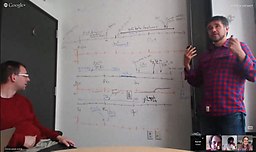by Automobile Technologies, Inc.
Do I buy or build software in-house or use SaaS?
Large remarketing firms, car rental companies, fleets, or auctions, profit and grow with deeply rooted sales and operational efficiencies. Simple right? Sell more, and trim the fat from the operation.
As growth happens and processes get put into place (often on the fly), the processes do not always grow with the organization. Over time, they can even become bottlenecks. This is the point when a lot of companies turn to software to streamline many of these inefficiencies and to trim the fat from the organization.
Software tools such as vehicle trackers, inspection software, and vehicle reconditioning management, are all available in various forms. The question then is which software is the right fit for your needs?
Sure you can. But why?
Many organizations find it tempting to turn to their own IT department to investigate the feasibility of just building their own software. The eager to please IT department always responds with a resounding “sure, we can do that”. The question often left unasked is, should you?
There are three types of software that remarketers use:
- A custom scratch-built application developed by the company’s own IT team.
- Software code that is purchased and then modified to suit the company’s needs.
- SaaS- cloud-based software that is sold on a subscription basis.
The lure of not having to pay subscription fees can be tempting to companies looking to trim overhead costs, and with code snippets available for purchase by eager IT guys, the investment never pays for itself and here is why.
Consider the time spent to define it.
When you buy a SaaS product it is available immediately. The only time spent is the time it takes to implement the software and train your staff. This is time you would have to spend anyway even if you built your own program.

Consider how many meetings it will take to lay out the features, the functionality, and the workflow, before you even begin to build the tool. This can take an organization six months or more just to determine what needs to be built and what it should do.

Consider the time spent to build it.
Now that you know what your software should do, and even how it should function, you can finally start to build it. But how long will that take? A couple of months perhaps even with a dedicated IT team who is not busy fixing other hardware and software issues within the business already.
Consider the time spent to refine and debug it.
Here we are nine months later and you finally have something that resembles a software. The only problem is when you click this button here, it crashes, or when you enter text there, it doesn’t show up on the report. Add a few more months to test and refine the software and you are now twelve months in before you have something functional.
Consider the fact that you will need to continually update it.
Let’s fast forward six months to a year and your organization has been utilizing your new software. But accounting has learned that its missing two crucial steps. Your buyer wants to be able to scan VIN’s and pull carfax reports, and marketing wishes that there were fewer steps to upload images to your website.
Also, because your software has been somewhat effective at cleaning up some processes, you were able to drastically streamline how you handle paperwork, but the software wasn’t built to handle the new process.
It’s time for some updates, and this will take some time and more capital investment.
Consider the savings you could have realized this whole time.
At eighteen months of development, refinement and field implementation, your software is working, but still needs work, and you will forever be chasing these updates. That is 18 months of organizational spend that you could have eliminated immediately had you simply purchased a subscription-based software.
The benefit of SaaS
Let’s look at this same eighteen months through the lens of a SaaS development company. Before even going to market, the needs have been identified, the business case made, the process mapped out, the testing had been done, and the software has begun to get purchased and implemented in early adopting dealerships. Now the feedback loop begins as customers start to identify bugs and new feature requests. The updates are immediately addressed, and the features are built quickly and brought to market to stay competitive.
But what about customization?
The last big lure for a dealership to develop their own software is the argument that it is 100% custom built for their organization. And while it is true that a SaaS product has been built for mass consumption and mass appeal, most high-end SaaS companies will offer customization to suit your needs.
You also get customer support and constant updates, refinements and new features at no additional cost.
Why reinvent the wheel?
That is an old saying but it holds true nearly every single time. At the end of the day, if you could build your own Quickbooks, why would you?
Companies, learn from those who have tried this before and have come to the same conclusion: Building your own software slows company progress when SaaS alternatives keep you out in front of the competition.